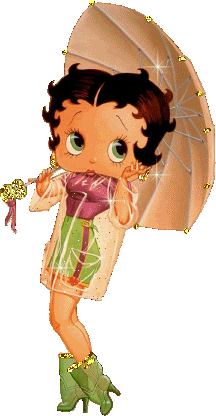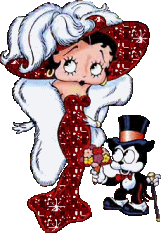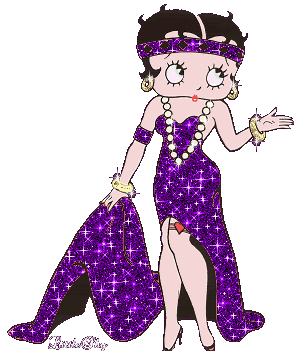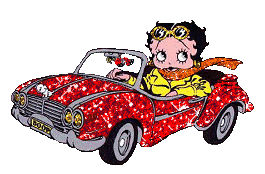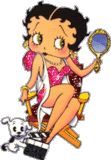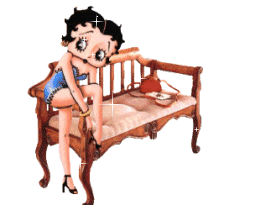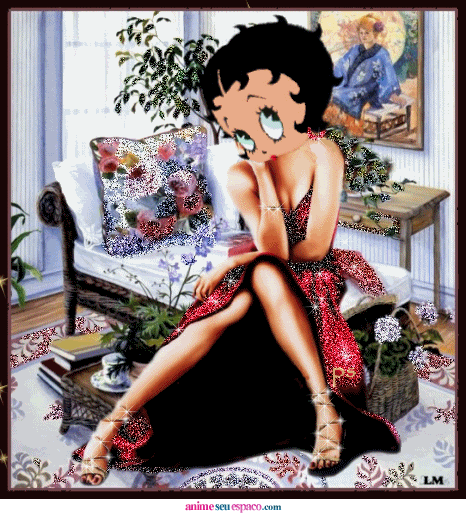Betty Boop
Più passa il tempo, più il mito della prima "eroina sexy" dei Cartoni animati - invece di affievolirsi nella memoria - si rafforza mostrando un'attualità sorprendente e diffondendosi su scala planetaria con continui ritorni di gloria. Merito di una intramontabile e originale carica ipnotica di femminilità e passione - con la sua inconfondibile "grande testa a forma di arachide su un corpo mozzafiato" - che si è mantenuta pressochè intatta dagli anni Trenta del secolo scorso sino ai giorni nostri. Merito di un carattere "rivoluzionario" ineguagliabile, nato dalla fervida e geniale mente dei prolifici e irriverenti fratelli Fleischer. Così l'eterna adolescente Betty (ufficialmente sempre 16enne) è un coacervo vivente - e umanissimo - di contraddizioni, racchiuse nel magico refrain-nonsense: Boop-oop-a-doop. è allo stesso tempo casta e provocante, ingenua e maliziosa, vergine e tentatrice, remissiva e aggressiva, tenera e dura, spensierata e disperata (e si potrebbe continuare all'infinito a suon di ossimori). Riesce a far convivere un fiabesco fumetto animato per bambini (un caravanserraglio di irresistibili cani, gatti e clown come co-protagonisti) con una pellicola per adulti (tanto da attirare le attenzioni oscurantiste della censura americana che ne decreteranno la fine) sconfinando - almeno nei suoi momenti più creativi - nel campo onirico del surreale e dell'orrorifico. Esattamente agli antipodi della stucchevole epopea Disneyana: basta confrontare le rispettive versioni di Biancaneve e i sette nani.
IL MITO DI BETTY è sostenuto anche con vigore da una musicalità ricca e travolgente - passata attraverso le ere del jazz e dello swing - tanto che alcuni Cartoni di Betty possono essere considerati a pieno titolo come veri e propri antesignani degli odierni "videoclip" (con interpreti del calibro di Louis Armstrong, Cab Calloway e Rudy Vallee). Va inoltre ricordato che la riscoperta e definitiva consacrazione di Betty, a cavallo fra gli anni Sessanta e Settanta del secolo scorso, avvenne come icona fra quelle scelte dai movimenti psichedelici dei "figli dei fiori" nel fermento dei Campus universitari americani. Ultimo pilastro del mito di Betty da evidenziare, ma non certo ultimo come importanza: le sceneggiature sulfuree e caleidoscopiche con un'animazione raffinata, studiata sin nei minimi particolari in modo certosino dai fratelli Fleischer - e supportata da innovazioni tecnologiche che hanno cambiato per sempre il mondo dei Cartoon - per riprodurre nel modo più realistico, fluente e naturale possibile le movenze umane. Da qui l'estrema credibilità di Betty - pur nell'aspetto caricaturale e sul filo di una onnipresente e svagata ironia, imbronciata e con la testa per aria - e dei suoi comprimari (sia virtuali che, talora, inseriti nella pellicola in carne e ossa). A proposito di comprimari: Betty ha incrociato la sua strada con personaggi del calibro di Braccio di ferro (favorendone persino l'esordio animato sullo schermo) e Felix-the-cat.
Due parole infine sugli inesauribili spunti di curiosità stimolati dalla "saga" di Betty (che, per altro, ha dato superficialmente vita negli anni anche ad una immane e lucrosa produzione di superflua oggettistica ispirata al suo personaggio, come ad improbabili derive para-pornografiche). Si parte dall'avvincente e fulminea trasformazione di Betty da cagnolina comprimaria a ragazza-vamp-star (con le orecchie canine scomparse, poi riapparse, infine sostituite dai grandi orecchini), per proseguire con i suoi molteplici e scandalosi flirt sul set. E ancora: le voci sulle formosità e le movenze ispirate ai disegnatori dello studio Fleischer dall'esperienza diretta delle "lucciole" nelle strade di New York o il giallo sulla leggenda di alcune singole inquadrature desnude - velocissimi frame (un solo fotogramma dei 24 che passano in un secondo) invedibili durante una normale proiezione - disseminate ad arte dagli autori. Tante le spigolature erotiche: i vestiti che cadono (e siamo nel 1930!), i giochi di trasparenze controluce, alcuni balli esotici vertiginosi e quella simbolica giarrettiera che - di volta in volta - passa da una gamba all'altra. Ma nella cesta dei ricordi c'è anche la causa da 250 mila dollari intentata nel 1934 contro gli autori da Helen Kane (e persa) per il risarcimento del presunto "furto" del suo stile e del ritornello-slogan "Boop-oop-a-doop" operato dall'eroina di celluloide. Un pensiero finale all'ultima fugace apparizione di Betty, in un cameo all'interno del cartone "Chi ha incastrato Roger Rabbit" (1988). Struggente, in bianco-e-nero, rivendica con orgoglio di possedere e custodire ancora il suo magico Boop-oop-a-doop, e passa idealmente la mano (e le scene) alle esplosive, sinuose e coloratissime curve di Jessica Rabbit.
Betty Boop History
Let's start from the very, very beginning, as we look at the history of my icon. It's always best.
The first appearance of Betty Boop was in the 6th Talkartoon starring Bimbo the Dog, entitled "Dizzy Dishes" (1930). Grim Natwick was the first Animator to draw Betty, who had not yet been officially named. And so began the history of Betty Boop, the world famous cartoon character!
Natwick took inspiration for Betty's spit curls from a song sheet of Helen Kane commonly called the "Boop Oop a Doop Girl". Her high baby voice, like her spit curls, were in imitation of singer Helen Kane. Her first starring role was in "Betty Coed" (1931), which also marked the first time the name "Betty" was connected with the character.
The first appearance of Betty Boop was in the 6th Talkartoon starring Bimbo the Dog, entitled "Dizzy Dishes" (1930). Grim Natwick was the first Animator to draw Betty, who had not yet been officially named. And so began the history of Betty Boop, the world famous cartoon character!
Natwick took inspiration for Betty's spit curls from a song sheet of Helen Kane commonly called the "Boop Oop a Doop Girl". Her high baby voice, like her spit curls, were in imitation of singer Helen Kane. Her first starring role was in "Betty Coed" (1931), which also marked the first time the name "Betty" was connected with the character.
Betty started out being designed as a human-like dog, only her black button nose and floppy ears hinting at her canine nature. She was initially the nameless girlfriend of Bimbo The Dog. This would develop into the popular and world famous character, Betty Boop. It's totally true! Betty started her career as a dog. She was a feminine canine foil to play opposite Bimbo.
In "Any Rags" (1932), Betty became completely human, and her ears permanently became earrings. As for her famous garter, Betty started out with two, then early drawings showing her still with ears show the garter on her right leg. When she became a regular, however, and her features were officially set, the garter moved to her left leg, and stayed there.
In "Any Rags" (1932), Betty became completely human, and her ears permanently became earrings. As for her famous garter, Betty started out with two, then early drawings showing her still with ears show the garter on her right leg. When she became a regular, however, and her features were officially set, the garter moved to her left leg, and stayed there.
Max Fleischer
Max Fleischer is best known as the co-founder of the famous Fleischer Studios, one of the first animation studios, which he started together with his brothers, Dave and Joe. Max Fleischer emigrated to New York City at an early age, studying Art at Cooper Union and the Art Students League.
Max was a pioneer in the animation business, responsible for creating the animation technique of rotoscoping. This involved drawing animation on top of frames from a live action film. The Fleischer Studio turned out some of the most inventive films of the period and Fleischer made the first sound cartoons of contemporary comic heroes like Popeye.
At the end of the 1920s, the studio's top artist Grim Natwick came up with a new female character: a seductive, nameless side-character who was modeled after Helen Kane, a waning Hollywood star at the time, known for her high-pitched "Boop-Oop-a-doop".This character, who was initially the nameless girlfriend of Bimbo the Dog, would develop into the popular and world famous character, Betty Boop.
In July 1932, the name 'Betty Boop' was officially launched through her first title screen role in "Betty Boop Limited". As the fame of the cartoon character increased, the popularity of the live actress and singer Helen Kane diminished, and she threatened with lawsuits, all of which were unsuccessful. In 1933, the Fleischer Studio was negotiating a comic about Betty Boop with King Features Syndicate. They couldn't agree on a price, and Helen Kane stepped in, suggesting a comic based on her name and appearance. So it is that Betty Boop first appeared in strip form as "Boop-Boop-a-Doop Girl by Helen Kane".
Fleischer was also responsible for introducing the first cartoons with sound in 1924. He used rotoscoping and sound to include popular contemporary jazz musicians of the time such as Cab Calloway and Louis Armstrong in his cartoons.
In the Betty Boop cartoon "Minnie The Moocher", Cab Calloway is shown animated as a bizarre walrus like character performing all the insane body movements Cab is known for.
Max was a pioneer in the animation business, responsible for creating the animation technique of rotoscoping. This involved drawing animation on top of frames from a live action film. The Fleischer Studio turned out some of the most inventive films of the period and Fleischer made the first sound cartoons of contemporary comic heroes like Popeye.
At the end of the 1920s, the studio's top artist Grim Natwick came up with a new female character: a seductive, nameless side-character who was modeled after Helen Kane, a waning Hollywood star at the time, known for her high-pitched "Boop-Oop-a-doop".This character, who was initially the nameless girlfriend of Bimbo the Dog, would develop into the popular and world famous character, Betty Boop.
In July 1932, the name 'Betty Boop' was officially launched through her first title screen role in "Betty Boop Limited". As the fame of the cartoon character increased, the popularity of the live actress and singer Helen Kane diminished, and she threatened with lawsuits, all of which were unsuccessful. In 1933, the Fleischer Studio was negotiating a comic about Betty Boop with King Features Syndicate. They couldn't agree on a price, and Helen Kane stepped in, suggesting a comic based on her name and appearance. So it is that Betty Boop first appeared in strip form as "Boop-Boop-a-Doop Girl by Helen Kane".
Fleischer was also responsible for introducing the first cartoons with sound in 1924. He used rotoscoping and sound to include popular contemporary jazz musicians of the time such as Cab Calloway and Louis Armstrong in his cartoons.
In the Betty Boop cartoon "Minnie The Moocher", Cab Calloway is shown animated as a bizarre walrus like character performing all the insane body movements Cab is known for.
The Fleischer Studios
Fleischer Studios, Inc. is an American corporation which originated as an animation studio located at 1600 Broadway, New York City, New York. It was founded in 1921 by brothers Max Fleischer and Dave Fleischer, who ran the company from its inception until being fired by parent company Paramount Pictures in January 1942.
In its prime, it was the most significant competitor to Walt Disney Productions, and is notable for bringing to the screen cartoons featuring Koko the Clown, Betty Boop, Popeye the Sailor and Superman. The company had its start when Max Fleischer invented the rotoscope which allowed for extremely lifelike animation. Using this device, the Fleischer brothers got a contract with Bray Studio in 1919 to produce their own series called Out of the Inkwell which featured their first character, This became a very successful series which gave them the confidence to start their own studio in 1921. The Superman series was Fleischer Studios' most successful late period project. However, this late success did not help the studio lift its financial trouble. The expanded staff of the new Miami studio created a high overhead, necessitating steady production.
In its prime, it was the most significant competitor to Walt Disney Productions, and is notable for bringing to the screen cartoons featuring Koko the Clown, Betty Boop, Popeye the Sailor and Superman. The company had its start when Max Fleischer invented the rotoscope which allowed for extremely lifelike animation. Using this device, the Fleischer brothers got a contract with Bray Studio in 1919 to produce their own series called Out of the Inkwell which featured their first character, This became a very successful series which gave them the confidence to start their own studio in 1921. The Superman series was Fleischer Studios' most successful late period project. However, this late success did not help the studio lift its financial trouble. The expanded staff of the new Miami studio created a high overhead, necessitating steady production.
Bimbo
He first appeared in the Out of the Inkwell series and was originally named Fitz. Betty Boop's boyfriend Bimbo is often confused for her dog Pudgy.
He later became the star of Fleischer's Talkartoons series, making his first appearance in Hot Dog (1930). He was relegated to a supporting character when his girlfriend, Betty Boop, became a more popular character. The Talkartoons series became the Betty Boop series in 1932.
He appeared in Max Fleischer cartoons from 1930 to 1933, when he was eliminated from Betty's series by the Production Code censorship laws, since a dog with a human girlfriend gave implications of bestiality.
You don't really hear much about Bimbo nowadays as Betty Boop has taken all the limelight,
which is fair enough as she is now a world star, loved by all ages!
He later became the star of Fleischer's Talkartoons series, making his first appearance in Hot Dog (1930). He was relegated to a supporting character when his girlfriend, Betty Boop, became a more popular character. The Talkartoons series became the Betty Boop series in 1932.
He appeared in Max Fleischer cartoons from 1930 to 1933, when he was eliminated from Betty's series by the Production Code censorship laws, since a dog with a human girlfriend gave implications of bestiality.
You don't really hear much about Bimbo nowadays as Betty Boop has taken all the limelight,
which is fair enough as she is now a world star, loved by all ages!
Pudgy
Pudgy is Betty Boop's faithful pet dog, but many confuse him with her boyfriend, Bimbo The Dog. I love little Pudgy-wudgy and think he is very cute but could not find any information on him!
It would seem that Betty Boop's dog Pudgy has been forgotton, even though some of us love him as much as Betty did Pudgy was her faithful puppy companion. Also seen in many cartoons with Betty were Grampy (who appeared in over 10 Betty cartoons), and the pretty boy Freddy, her sometime love interest, as well as a host of other personified animals most of whom disappeared after 1934.
While in the earlier cartoons, one might find stories about Betty and Bimbo running away and getting terrorized by a singing, ghostly Cab Calloway walrus in a cave full of skeletal-looking geologic formations, the later cartoons have stories about Betty bringing home a cute but mischievous little baby monkey who gets into scraps with her dog, Pudgy. Betty's dress falls well below the knees, and has a collar and sleeves. Betty also becomes taller and smaller-headed. This incredible change occurred because, around 1935, the Hays Act was passed. The Hays Act was created to "clean up" the media. It censored movies and cartoons, transforming Betty Boop into a wholesome and, compared to her former self, rather uninteresting character. Still, Max Fleischer managed to slip one past the Hays Act in a cartoon called "A Language All My Own," in which Betty sings to a Japanese audience in both English and Japanese. The English version of the song is quite innocent, but the Japanese version, when translated, contains a verse that goes something like this: "Come to bed with me and we'll boop-oop-a-doop!" .
It would seem that Betty Boop's dog Pudgy has been forgotton, even though some of us love him as much as Betty did Pudgy was her faithful puppy companion. Also seen in many cartoons with Betty were Grampy (who appeared in over 10 Betty cartoons), and the pretty boy Freddy, her sometime love interest, as well as a host of other personified animals most of whom disappeared after 1934.
While in the earlier cartoons, one might find stories about Betty and Bimbo running away and getting terrorized by a singing, ghostly Cab Calloway walrus in a cave full of skeletal-looking geologic formations, the later cartoons have stories about Betty bringing home a cute but mischievous little baby monkey who gets into scraps with her dog, Pudgy. Betty's dress falls well below the knees, and has a collar and sleeves. Betty also becomes taller and smaller-headed. This incredible change occurred because, around 1935, the Hays Act was passed. The Hays Act was created to "clean up" the media. It censored movies and cartoons, transforming Betty Boop into a wholesome and, compared to her former self, rather uninteresting character. Still, Max Fleischer managed to slip one past the Hays Act in a cartoon called "A Language All My Own," in which Betty sings to a Japanese audience in both English and Japanese. The English version of the song is quite innocent, but the Japanese version, when translated, contains a verse that goes something like this: "Come to bed with me and we'll boop-oop-a-doop!" .
Grampy
This is Grampy from Betty Boop cartoons! Not many people know about him as Betty Boop has taken all the limelight, and rightly so! Anyhoo, here's a little page about him, because I don't want to leave him out! There were eight fun filled cartoons with the delightful Grampy, wild Inventor extraordinaire, whom it was said was based on Betty Boop creator, Max Fleischer. In one cartoon Grampy, an old fellow who works for the weather bureau, is fast asleep, and when the rain starts to fall, it activates a fancy sequence of events resulting in him awakening.He hearkens to the weather, and raises a giant umbrella over the city. We get to hear his voice when he makes an exclamation; he sounds like Grampy.
The invention designed to wake him up and the unlikely solution to the problem of rain (the giant umbrella) are all characteristics of Grampy.
The invention designed to wake him up and the unlikely solution to the problem of rain (the giant umbrella) are all characteristics of Grampy.
Helen Kane
Her first starring role was in "Betty Coed" (1931), which also marked the first time the name Betty was connected with the character.
Like many performers burdened with one overwhelming association, Kane's career was actually much more diverse. She was involved with show business for much of her life, not only as a singer but also as an actress in the early-'30s Hollywood films and a costume designer as well.
Kane was a Bronx gal whose real name was Helen Schroeder. Some mildly amusing siblings known as the Marx Brothers were the ones who got her started in show business. She was 17 at the time. She began appearing in Broadway musicals in 1927, and a 1928 show entitled "Good Boy" was the source of the "boop-boop-be-doop," a musical request entitled "I Wanna Be Loved by You" specifically. An aspect of her approach to the song, delivering it in a toddler's voice, in turn became a stylistic trademark of some of the so-called "flapper" tuneage created by singers such as Kane and Annette Hanshaw.
The character of Betty Boop evolved out of all this while Kane was a contract player at the Paramount studio, also the home of animation genius Max Fleischer . It wasn't he who first drew the character, however. The original Animator, the pleasant-sounding Grim Natwick supposedly created Betty Boop by combining attributes of Kane and a French poodle!
In a 1950 film biography of "I Want to Be Loved by You" songwriters Kalmar & Ruby, the part of Kane was played by none other than Debbie Reynolds, but it is actually Kane's voice providing the "boop-boop-be-doop".
Mae Questel
Like many performers burdened with one overwhelming association, Kane's career was actually much more diverse. She was involved with show business for much of her life, not only as a singer but also as an actress in the early-'30s Hollywood films and a costume designer as well.
Kane was a Bronx gal whose real name was Helen Schroeder. Some mildly amusing siblings known as the Marx Brothers were the ones who got her started in show business. She was 17 at the time. She began appearing in Broadway musicals in 1927, and a 1928 show entitled "Good Boy" was the source of the "boop-boop-be-doop," a musical request entitled "I Wanna Be Loved by You" specifically. An aspect of her approach to the song, delivering it in a toddler's voice, in turn became a stylistic trademark of some of the so-called "flapper" tuneage created by singers such as Kane and Annette Hanshaw.
The character of Betty Boop evolved out of all this while Kane was a contract player at the Paramount studio, also the home of animation genius Max Fleischer . It wasn't he who first drew the character, however. The original Animator, the pleasant-sounding Grim Natwick supposedly created Betty Boop by combining attributes of Kane and a French poodle!
In a 1950 film biography of "I Want to Be Loved by You" songwriters Kalmar & Ruby, the part of Kane was played by none other than Debbie Reynolds, but it is actually Kane's voice providing the "boop-boop-be-doop".
Mae Questel
Filmography 
Here is a complete list of all the Betty Boop Films and Betty Boop Cartoons that Betty appeared in:
1930
"Talkartoons"
• Dizzy Dishes - 8/9/30
[Betty's first appearance as an unnamed canine character]
• Barnacle Bill - 8/31/30
• Mysterious Mose - 12/26/30
"Talkartoons"
• Dizzy Dishes - 8/9/30
[Betty's first appearance as an unnamed canine character]
• Barnacle Bill - 8/31/30
• Mysterious Mose - 12/26/30
1931
"Talkartoons"
• The Bum Bandit - 4/3/31
Paramount (sound) - Screen Songs Cartoons
• Any Little Girl That’s A Nice Little Girl - 4/16/31
"Talkartoons"
• Silly Scandals - 5/23/31
Paramount (sound) - Screen Songs Cartoons
• Betty Coed (Rudy Vallee) - 8/1/31
[A prototype character for Betty; an adventure in which she earns her first name]
"Talkartoons"
• Bimbo’s Initiation - 7/24/31
• Bimbo's Express - 8/22/31
• Minding The Baby - 9/26/31
Paramount (sound) - Screen Songs Cartoons
• Kitty From Kansas City (Rudy Vallee) - 10/31/31
• Mask-A-Raid - 11/7/31
"Talkartoons"
• Jack And The Beanstalk - 11/21/31
• Dizzy Red Riding Hood - 12/12/31
1932
"Talkartoons"
• Any Rags - 1/12/32 [Betty's first appearance as a girl]
• Boop-Oop-A-Doop - 1/16/32
• The Robot - 2/5/32
• Swim Or Sink - 3/11/32
• Crazy Town - 3/25/32
• Minnie The Moocher (Cab Calloway and his Orchestra) - 2/26/32
• The Dancing Fool - 4/8/32
Paramount (sound) - Screen Songs Cartoons
• Oh! How I Hate To Get Up In The Morning - 4/22/32
"Talkartoons"
• A Hunting We Will Go - 4/29/32
• Chess-Nuts * 5/13/32
Paramount (sound) - Screen Songs Cartoons
• Let Me Call You Sweetheart (Ethel Merman) - 5/20/32
• You Try Somebody Else (Ethel Merman) - 5/20/32
"Talkartoons"
• Admission Free - 6/10/32
• Betty Boop Limited - 7/1/32
Paramount (sound) - Screen Songs Cartoons
• Rudy Vallee Melodies - 8/5/32
Betty Boop Cartoons
• Stopping the Show - 8/12/32
• Betty Boop's Bizzy Bee - 8/19/32
• Betty Boop, MD - 9/2/32
• Betty Boop's Bamboo Isle (Royal Samoans with Miri) - 9/23/32
• Betty Boop's Ups and Downs - 10/14/32
Paramount (sound) - Screen Songs Cartoons
• Romantic Melodies (Arthur Tracy) - 10/21/32
Betty Boop Cartoons
• Betty Boop For President - 11/4/32
• I'll Be Glad When You're Dead You Rascal You (Louis Armstrong) - 11/25/32
• Betty Boop's Museum - 12/16/32
1933
Betty Boop Cartoons
• Betty Boop's Ker-Choo - 1/6/33
• Betty Boop's Crazy Inventions - 1/27/33
• Is My Palm Read - 2/17/33
• Betty Boop's Penthouse - 3/10/33
• Snow White - 3/31/33
Paramount (sound) - Screen Songs Cartoons
• Popular Melodies (Arthur Jarrett) - 4/7/33
Betty Boop Cartoons
• Betty Boop's Birthday Party - 4/21/33
• Betty Boop's May Party - 5/12/33
• Betty Boop's Big Boss - 5/2/33
• Mother Goose Land - 6/23/33
• Popeye The Sailor - 7/14/33
• Old Man Of The Mountain (Cab Calloway) - 8/4/33
• I Heard (Don Redman) - 9/1/33
• Morning, Noon And Night (Rubinoff) - 10/6/33
• Betty Boop's Halloween Party - 11/3/33
• Parade Of The Wooden Soldiers (Rubinoff) - 12/1/33
1934
Betty Boop Cartoons
• She Wronged Him Right - 1/5/34
• Red Hot Mama - 2/2/34
• Betty Boop in Ha! Ha! Ha! - 3/2/34
• Betty In Blunderland - 4/6/34
• Betty Boop's Rise to Fame - 5/18/34
• Betty Boop's Trial - 6/15/34
• Betty Boop's Life Guard - 7/13/34
Color Classics
• Poor Cinderella (Cinecolor) - 8/3/34
Betty Boop Cartoons
• There's Something About A Soldier - 8/17/34
• Betty Boop's Little Pal - 9/21/34
• Betty Boop's Prize Show - 10/19/34
• Keep In Style - 11/16/34
• When My Ship Comes In - 12/21/34
1935
Betty Boop Cartoons
• Baby Be Good - 1/18/35
• Taking The Blame - 2/15/35
• Stop That Noise - 3/15/35
• Swat That Fly - 4/19/35
• No! No! A Thousand Times No! - 5/24/35
• A Little Soap And Water - 6/21/35
• A Language All My Own - 7/19/35
• Betty Boop And Grampy - 8/16/35
• Judge For A Day - 9/20/35
• Making Stars - 10/18/35
• Betty Boop With Henry, The Funniest Living American - 11/22/35
• Little Nobody - 12/27/35
1936
Betty Boop Cartoons
• Betty Boop And The Little King - 1/31/36
• Not Now - 2/28/36
• Betty Boop And Little Jimmy - 3/27/36
• We Did It - 4/24/36
• A Song A Day - 5/22/36
• More Pep - 6/19/36
• You're Not Built That Way - 7/17/36
• Happy You And Merry Me - 8/21/36
• Training Pidgeons - 9/18/36
• Grampy's Indoor Outing - 10/16/36
• Be Human - 11/20/36
• Making Friends - 12/18/36
1937
Betty Boop Cartoons
• House Cleaning Blues - 1/15/37
• Wiffle Piffle In Whoops! I'm A Cowboy - 2/12/37
• Wiffle Piffle In The Hot Air Salesman - 3/12/37
• Pudgy Takes A Bow-Wow - 4/9/37
• Pudgy Picks A Fight - 5/14/37
• The Impractical Joker - 7/18/37
• Ding Dong Doggie - 7/23/37
• The Candid Candidate - 8/27/37
• Service With Smile - 9/23/37
• The New Deal Show - 10/22/37
• The Foxy Hunter - 11/26/37
• Zula Hula - 12/24/37
1938
Betty Boop Cartoons
• Riding The Rails - 1/28/38
• Be Up To Date - 2/25/38
• Honest Love And True - 3/25/38
• Out Of The Inkwell - 4/22/38
• Swing School - 5/27/38
• The Lost Kitten - 6/24/38
• Buzzy Boop - 7/29/38
• Pudgy The Watchman - 8/12/38
• Buzzy Boop At The Concert - 8/16/38
• Sally Swing - 10/14/38
• On With The New - 12/2/38
• Pudgy In Thrills And Chills - 12/23/38
1939
Betty Boop Cartoons
• My Friend The Monkey - 1/27/39
• So Does An Automobile - 3/31/37
• Musical Mountaineers - 5/12/39
• The Scared Crows - 6/9/39
• Rhythm On The Reservation - 7/7/39
• Yip Yip Yippy - 8/11/39
1985
Betty Boop Cartoons
• The Romance of Betty Boop - 3/20/85
[CBS Television half-hour animated musical special]
